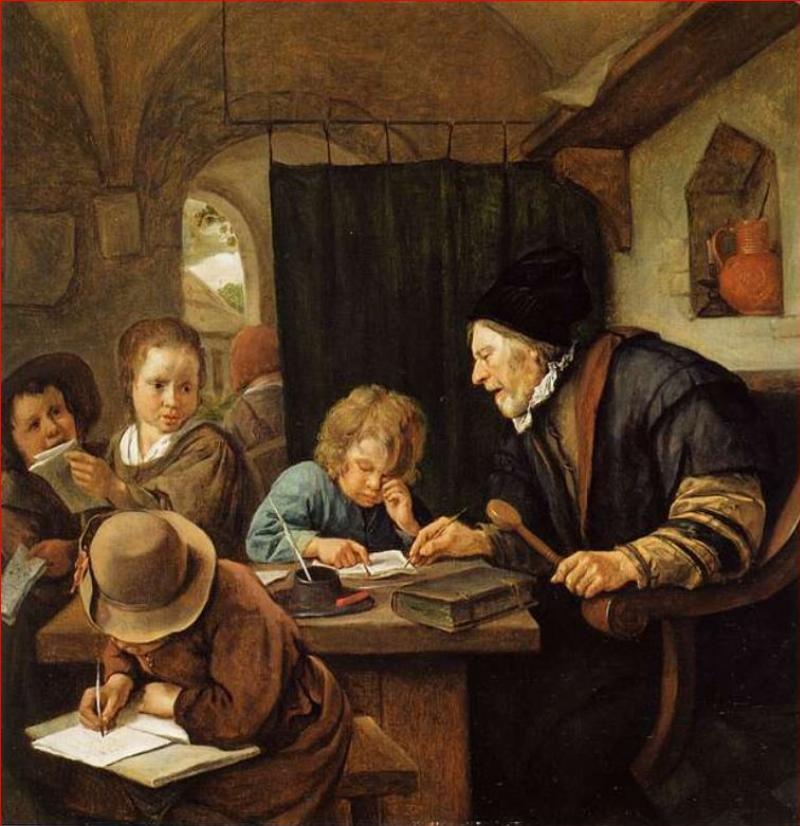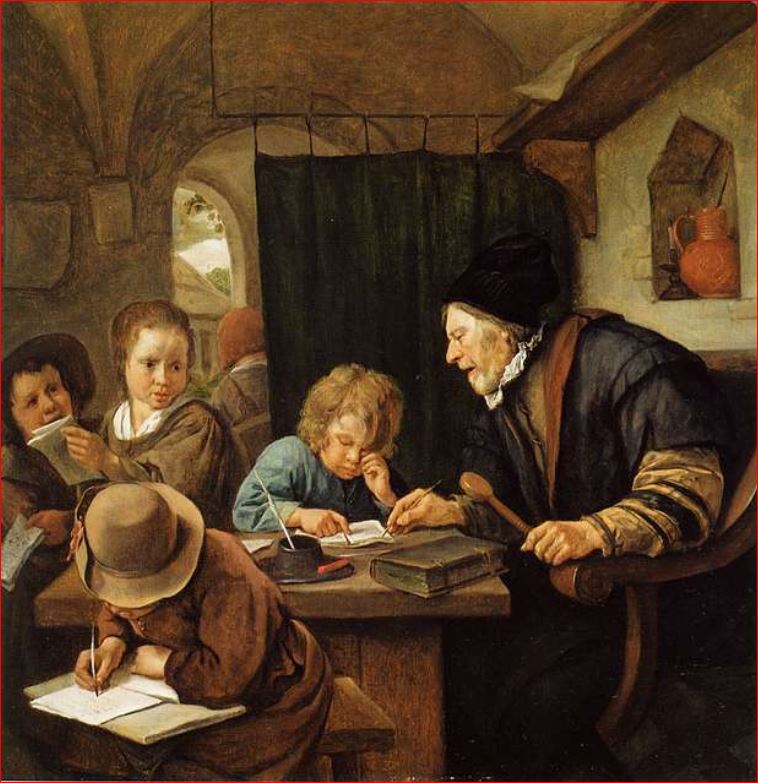

Photo Credit:Jan Steen school painting
picryl
A weak reading of the Constitution by a previous Supreme Court justice has pretty well cast God, but not gays, out of public schools.
In the late 1940s, Supreme Court Justice Hugo L. Black, in the case of Everson v. United States, took a quote from a letter written by Thomas Jefferson out of context and insisted that the wall of separation between church and state “should be high and impregnable.”
Despite some variability, this position became the basis for the Court’s interpretation of the separation of church and state which led to the banning of prayer and Bible reading in the public schools at the beginning of the 1960s.
Separation of church and state means (1) that taxes should not be used to support an official national church (denomination) of Christianity, (2) that there would be no church recognized as the official church for the nation or for any state, and (3) no one will be fined or jailed for not agreeing with the doctrine of any denomination or church.
That “separation” became the basis for excluding William Blackstone’s affirmation that the Bible provides the natural law basis for understanding the civil and criminal law.
That view has since been diluted by what conservative judges call an “originalist interpretation” of the law. So-called conservative jurists refer to the original meanings of terms used in early Supreme Court decisions, but unlike the 18th century lawyers of the William Blackstone era in England, they cannot refer to “Nature’s Law” or the Holy Bible in support of their decisions. That would be true originalist conservatism, but would not be consistent with the separation of church and state affirmed in various decisions 60-75 years ago …
In our public schools, “separation” came to mean students could not pray with or be led in prayer or be even asked to pray (with the right not to pray) by their teacher in any classroom. No teacher could read the Bible aloud to the students, but had to check his or her explicit faith at the door.
That “separation” was taken to mean that the Ten Commandment could not be posted anywhere in any school. A saying from anywhere in the Bible could not be posted in any school. So I would ask “If having books about non-straight lifestyles can be read or even read aloud in schools and that is considered by those who do it as promoting tolerance for drag queens, transgenders, and homosexuals, but not necessarily promoting or imposing identification with and/or practicing those behaviors, why is it that reading from the Bible is considered imposing religion and not considered promoting free will tolerance of people who are Bible believing?”
Despite the stigma of being a born-again Christian in the public high schools 20 years ago, a Jewish teacher invited me to his class when he was teaching about cultural responses to the Civil War. He asked if I would join a group of students who would lead the class in singing “The Battle Hymn of the Republic.” I agreed, and all joined in with the six students and myself at the front of the classroom. The class was 70% composed of first-generation Chinese students. Although some were Christian, most had no religious commitments. The song captured the flavor of Northern anti-slavery politics as it combined with the dominant Christian ideology of that period.
The Jewish teacher and I were technically pushing the limits of our freedom of expression or going beyond literal limits, but there was no imposition. The class teacher asked one young man why he was not singing, and he replied that it was “against his religion.” The teacher respectfully did not insist that he join in. After the class when I asked the teacher why he taught the song he said that he simply wanted to give the class a sense of the spirit of that era and the spiritual sense that motivated the soldiers’ historical response.
In another interesting incident also about 20 years ago, the assistant principal of counselling at a school had given his phone number for a disturbed student to call him if he felt very upset or even suicidal. The student called him at 3:00 a.m. one morning in an effort to stave off suicidal thoughts, and the AP talked with him until he felt better. Since it was the Christmas season, in gratitude for the assistant principal’s sacrificial compassion, the student bought him a crèche, which the AP displayed in his office. An arch-atheist woman counselor reported him to the Department of Education for promoting Christian religion, and incredibly two investigators from the central office of the Department of Education came to evaluate this possible violation of separation of church and state. Happily, he was not punished.
Further, through God’s infinite justice, shortly thereafter, the same woman who insisted that he was in violation of the U.S. Constitution lashed out and punched another middle-aged woman counselor who, like her, was committed to a leftist agenda. She had punched her best friend in the counselling division and was subsequently removed from her duties, put in isolation in a separate office, and forced into early retirement.
An idiotic situation like her accusation of the AP would never have taken place if there was no legal doctrine of separation of church and state in our schools, which doctrine is fiercely justified in the minds of the far left employees of the school system.
Yet, we also see a great irony in that, despite that doctrine, the leftist adherents of this doctrine issued no complaints when Muslim students in the school – despite or perhaps because of the 9/11 attacks on the World Trade Center and the Pentagon — 20 years ago were given a room to use as a prayer room during the school day!! Neither Jewish nor Christian students were offered their own space for a service or for prayer.
One writer, David Callaway, writes “But ultimately, preventing government from interfering with religion is an essential principle of religious liberty.” He sees the elimination of the Bible and prayer from our schools as preventing interference with religion, but the purpose is to make the person of God persona non grata in our schools.
Ultimately this view in defense of keeping all religion out of public education as much as possible (with recent Muslim access as an exception) is a rejection of freedom of religion.
The student has a right to be any religion he or she chooses to be, but public sanctioning of faith is missing. Institutional structures to honor faith are missing. Those beliefs cannot be expressed on a daily basis as being just as legitimate as learning about history or geometry, and in fact as essential to that learning since a faithful Christian at least will be thanking the Lord God for the opportunity to learn math, science, or a foreign language.
We need to find creative ways to restore faith in Almighty God to our public educational institutions. It is essential for our return to being a more moral nation. Aren’t 60+ years where God can’t even ride in the back of the bus sufficiently disgraceful that we need a revision?
Image: Netherlands Institute for Art History, via Picryl/Gary Stockbridge // public domain






